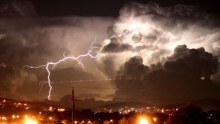The recession we won't have to have
Updated
Had the great Greek philosopher Aristotle been an economic pundit in 2016 he may well have said something pithy like, "One swallow does not a summer make; similarly, one quarter of negative GDP does not make an economy recessionary".
Certainly the September quarter's -0.5 per cent reverse makes for glum reading, but it is hardly a harbinger of recession and an economic winter setting in.
Looking back at previous negative quarters dotted sparsely through the past 25 years of largely economic expansion points more to the likelihood of a subsequent growth spurt than autumnal senescence.
A brief history of negative GDP
Over the past 100 quarters there have been just four where the economy has gone backwards as measured by the Australian Bureau of Statistics' "gross domestic product, chain volume measures (percentage change)".
The last instance was a 0.2 per cent decline in March 2011 following the devastating summer storms which inundated southern Queensland.
Towns were wiped out, around 200,000 people were affected, coal mines were flooded and around $40 billion was wiped off GDP after weeks of flooding rains over the Christmas-New Year period of 2010/2011.
The subsequent quarter, reported strong GDP growth of 1.1 per cent and at least 1 per cent growth a quarter over the next 12 months.
The GFC hit in the December quarter of 2008 with GDP registering -0.7 per cent. Once again, GDP rebounded 1.1 per cent in March 2009.
Eight years earlier, December 2000 coughed up a -0.3 per cent result in response to the introduction of the GST six months earlier.
Consumers went on strike and a technical recession was narrowly avoided, with the September quarter having recorded zero growth.
But that did not last long - the urge to spend was too strong and GDP rebounded by 1.1 per cent in the March quarter.
Before that was the 1991 double header; Australia's last recession and famously, as then treasurer Paul Keating said, "a recession that Australia had to have".
Growth in the June and March quarters retreated 0.1 and 1.3 per cent respectively.
The rebound out of that was far more sluggish, but the whole economy was pretty wobbly back then, with four of the seven quarters from December 1989 negative, as interest rates soared and businesses collapsed.
Why do recessions hit?
There are a few basic reasons why recessions occur according to Market Economics' Stephen Koukoulas, and none of them point to an impending problem in Australia.
"It can come from a policy error, and we don't have that," Mr Koukoulas said.
"It can be a global shock, such as the GFC, but globally things are improving and commodity prices are rising.
"Then there are internal issues, specific to an economy, like banks lending too much, but that isn't happening either.
"That doesn't mean a recession won't happen, there is always a risk, but it doesn't seem likely."
Why did the economy go backwards in the last quarter?
Perhaps the simplest explanation is that GDP readings in the first half of the year were unrealistically strong.
"Having had a surprisingly good first half, we've had a surprisingly bad quarter," Mr Koukoulas said.
Morgan Stanley's Daniel Blake predicted a negative quarter some time ago and noted his forecast didn't reflect recessionary dynamics, but rather a correction of earlier "overstated growth".
"We have been arguing that Australia's 'real GDP' of 3.3 per cent year-on-year feels overstated, with the sharp decline in commodity prices driving an 'income recession' over 2014-15," Mr Blake wrote in a recent note.
"More recently both the first and second quarter results benefited from 'one-offs' - notably a benign cyclone season for exports, a surprise boost to public spending (including on helicopters) and a (positive) inventory build."
And they are pretty well the bits of economy that chopped chunks out of GDP this time. Weak capex, weak government spending and weak net exports all did the damage.
So is a big rebound likely?
While history points to a solid rebound next March, it is far from a certainty.
On the favourable side of the leger, policy settings are still easy; interest rates are low and likely to stay that way for some time.
Commodity prices are improving and the terms of trade are on the way back up from historic lows.
The Reserve Bank cut itself some slack in keeping interest rates on hold in December by noting growth may dip in the near term, before the higher commodity prices "provide a boost to national income".
Weighing against this, wages growth remains weak, unemployment could start edging up again and there is mounting evidence the residential construction boom may have peaked, or at least is about to peak.
So, while the economy is not necessarily going backwards, or even stalled, it certainly is not changing up through the gears and accelerating out of its below trend growth just yet.
The betting remains the RBA may still need to cut interest rates a bit more next year to head off another reverse in GDP and the possibility of recession.
Topics: economic-trends, business-economics-and-finance, markets, australia
First posted









